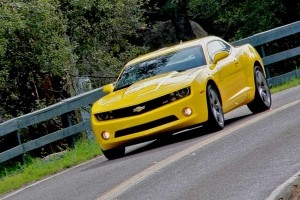
If timing is everything, does a 0 - 60 time of 4.7 seconds count? Okay fuel economy might help.
Timing is everything – especially when it comes to muscle cars. It’s hard to argue against 0 to 60 times, of course. This is a class that embraces the hare, not the tortoise. But timing matters in another sense. The original Ford Mustang hit the streets at precisely the right time to launch the pony car craze, and enthusiasm seemed even stronger when the first Chevrolet Camaro followed, two years later.
Ford hit it right, once again, with the 2002 Mustang, which launched the short-lived retro craze. Dodge, however, couldn’t have planned it worse with the introduction of the resurrected Challenger, which hit market just as oil prices started soaring to record levels. So what to make of the reborn, 2010 Camaro, which went into production this week?
There’s no question it’s long overdue. The concept version made its debut at the 2006 North American Auto Show, and was unquestionably the star of that event. But a lot has changed in those three years. While fuel prices have settled back from their mid-’08 peak, everyone expects they’ll shoot back up when the recession ends. And that pesky economic downturn has resulted in the lowest demand for new cars since, well, not long after the original Chevy Camaro rolled into showrooms, more than four decades ago.
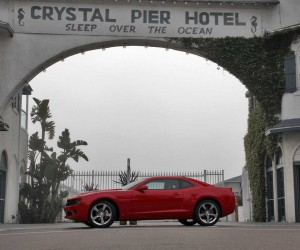
With a 6-speed gearbox, the 2010 pony car is surprisingly easy to drive around town.
Am I ready, then, to write off the all-new Camaro? Far from it, for Chevy’s new offering has lots going for it and delivers plenty of nice surprises – starting with those sweet 0 to 60 times of 4.7 seconds for the V-8, with either stick or automatic, and an equally impressive 6.1 seconds for a reasonably high-mileage V-6 that may be the most significant news of the Camaro’s debut. Chevy is weighing in with a seriously competitive base price, as well. And while retro may no longer be the draw that it was when the Mustang made its appearance, Camaro’s got a crisp, exciting look that readily turns heads.
That was brought home while driving the car around San Diego, where I had the chance to spend a couple days familiarizing myself with the new pony car. It’s not a place where you normally think of domestic brands or see many of them, especially Detroit muscle cars, other than the classics you’ll see cruising on the weekends.
“I just don’t pay attention to stuff from Detroit,” admitted the valet at the beachfront hotel where I was staying. Perhaps, but plenty of other folks did notice the new Camaro. Pulling into a sandy cul de sac, the new Chevy was quickly surrounded by beach-goers who wanted to know more about the car. As we headed off for a long drive, starting in downtown San Diego, then heading into the hills towards Palm Springs, it was hard to ignore the attention we were getting. With only rare exceptions – notably a 30-something driver in a beat-up Honda Civic – the reactions were friendly and positive. As we pulled into a small country store near the Mexican border, the cashier jumped onto her phone, breathlessly shouting out to an unseen friend, “Quick, get everyone down here. You’ve got to see this!”
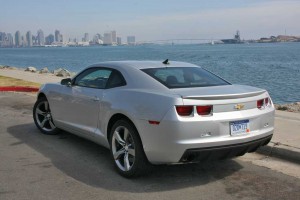
Dimensions have changed only slightly from the 2006 concept, though the production car is decidedly heavier and big in look and feel.
What they saw was a sports coupe that has a lot in common with the Camaro show car that captured everyone’s imagination when it debuted in January 2006. The look harkens back to the 1969 Camaro, arguably the most popular ever, with its egg crate grille, coke bottle silhouette, and the muscular kick-up of its rear shoulders.
Call it retro, if you must, but the design is a decidedly modern interpretation, and takes advantage of modern design and engineering technology. The entire side aperture – we’re talking nose-to-tail – is a single stamping and Gene Stefanyshyn, the project’s Vehicle Line Executive, recalled the challenges faced getting it off the stamping press without tearing the metal. The approach provided a number of technical advantages, once solved, but more significant is the way it looks: sleek and sophisticated in a way you’d never have seen during the original pony car era.
The roofline boasts a distinctive touch, dubbed the Mohawk, by GM designers. (It’s not available if you opt for a sunroof. There are plenty of enticing features, including the “halo ring” that surrounds the headlights on the RS and SS models. Otherwise, the visual distinction between base, RS and SS models is relatively modest. Chevy was planning a more distinctive look for the super high-performance Z28 but, well, more or less on that, in a moment.
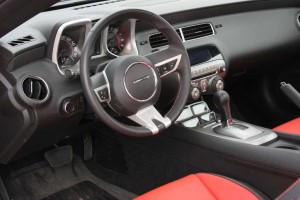
Not surprising that the retro package loses some of the over-the-top touches of the 2006 concept.
Once you got past the striking exterior of the Camaro concept you were greeted with an unexpectedly sophisticated cabin was far more refined than the classic muscle car. One of the most striking details were the colored door panel inserts. They’re gone on the production car, and the remaining package reflects the fact that GM had to remind its designers to stay within budget. But the 2010 Camaro’s cockpit is still a far better execution than the competition’s, the Challenger, in particular. The instrument cluster is unabashedly retro, but functional and easy to read. It does take a bit of time to get used to the extremely high instrument panel.
Camaro’s seats are comfortable and supportive, so even when you’re driving hard through some challenging mountain passes, you won’t be jounced around much.mAs for the back seat, you could actually climb in and stay reasonably comfortable for a jaunt around town, but we wouldn’t want to be stuck back there on a long trip.
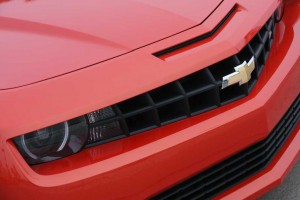
With good design it's all in the details, like the halo rings around the headlights.
In the old days, you would’ve had a tinny AM radio blaring to keep you company, maybe an 8-track, if you had the extra cash. The new Camaro features a single-CD system, with a good 6-speaker Bose audio package. The upgrade is a nine-speaker Boston Acoustics system. XM is standard, as is OnStar. And in recognition of modern realities, there’s not only a Bluetooth hands-free phone system but a Bluetooth audio package which can hook up to some MP3 audio players wirelessly. Otherwise, you can link your iPhone or iPod directly, and use the radio controls to change tracks.
It’s difficult to avoid comparisons with the concept Camaro, so let’s run the numbers: the production pony car’s wheelbase is two inches longer, though overall length is about the same, thanks to shorter front and rear overhangs. The roof sits 1.5 inches higher, according to exterior designer Sang Yup Lee, while the car is about two inches narrower. If there’s anything to be particularly concerned with, it’s the fact that the Camaro has gained some weight in the final development process, and now tips the scale at about 3700 for the typically-equipped V-6 and at least 3800 pounds for one of the V-8 packages.
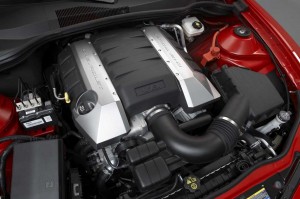
The Corvette-derived LS3 makes 426 hp with the 6-speed stick, 400 with the automatic. Either way, you'll turn 0 - 60 in 4.7 seconds.
Despite that heft, this machine moves. The powertrain package you’ll probably see most reviews focus on is the 6.2-liter LS3 V-8 in the Camaro SS. Simply put, it’s a rocket, making a solid 426 horsepower and 420 lb-ft of torque with the short-throw Tremec 6-speed manual gearbox. Mate the LS3 to the 6-speed automatic and it loses a bit of power, coming in at a rated 400 hp and 410 lb-ft. Surprisingly, Chevy engineers claim the car will pull the same 0 to 60 times, 4.7 seconds, with either transmission package. With the automatic, the big V-8 gets cylinder deactivation, which means that during light loads on the highway, only four cylinders are fed fuel. That boosts highway mileage to 25 mpg, compared with 24 for the stick, while the city cycle rating is a unimpressive 16 mpg for stick or automatic.
Big 20-inch tires, standard with the Camaro SS, do a great job of putting power to the pavement. You’ll have to work hard to do a burn-out, even with the stick, though we expect plenty of muscle car aficionados to try.
While the very phrase, “muscle car,” implies performance, the reality of the segment is that something north of two-thirds of all buyers traditionally opt for the less expensive and more fuel-stingy V-6 offerings. Here that translates into a version of the 3.6-liter, Direct Injection six-banger used in the Cadillac CTS. With its cam phasing system, it can deliver a reasonably good balance of fuel economy and acceleration. Both stick and automatic are rated at 304 horsepower and 273 lb-feet of torque. With the 6-speed manual, you’ll get an EPA-rated 17 in the city, while the 6-speed auto bumps that to 18. What’s making headlines that the engine yields an impressive 29 mpg on the EPA highway cycle with either gearbox.
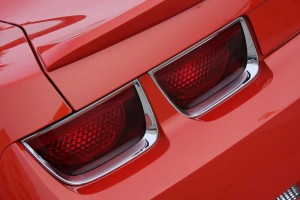
The view the competition may have to get used to.
You’ll be seeing Chevy make a lot out of the fact that Camaro comes with an independent rear suspension, unlike the live axle in arch-rival Ford’s Mustang. It’s a 4.5-link design, while there’s a dual ball front strut. There are two suspension levels, as you might expect, with a stiffer, lower version for the SS. Hollow stability bars are used, front and back.
Memory has a way of giving everything a rosy glow, and it’s easy to forget just how much of a handful the ’69 Camaro was to drive. Like all the muscle cars of its era, it was great at straight-line acceleration, but not much else, such as scrubbing off all that speed. The new sport and V-8 packages get not only 20-inch wheels and tires (otherwise, you can opt for 18s or 19s), but big Brembo 4-piston brakes. That’s a major plus, but so is the fact that to Chevy’s credit, GM’s StabiliTrak stability control system is standard fear on all models. ABS, Traction Control and Brake Assist are standard, as well. Chevy has hit the five-star crash ratings numbers, and Camaro comes with six airbags, as well as seatbelt pretensioners and load limiters. All of these of course add up to serious weight problem that reduces performance, fuel economy and handling. It’s a vicious cycle — big car needs big heavy tires and wheels, needs larger brakes, needs heavier suspension pieces and mounting points, needs expensive steels, loses fuel economy… you get the idea.
On the V8 SS and V-6 RS models, you also get a Competition Sport Mode, which virtually shuts down all those brake-controlled systems, as well as Launch Control, a feature designed to make it easier to get maximum torque to the ground during a hard launch.
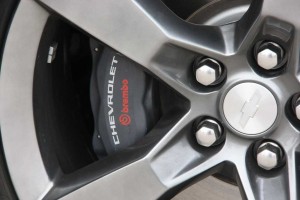
Classic muscle cars were all about straight-line acceleration. With 4-piston Brembo brakes, the 2010 Chevy Camaro has plenty of stopping power.
And what’s that launch like? Pretty exhilarating. While the SS won’t keep up with the high-line Ford Shelby Cobra, the Camaro will absolutely bury the standard-issue Mustang GT, which makes about 100 hp less. The V-6 is even more of a standout, by comparison. Ford’s six-banger is a modified truck engine and only barely up to the job. The Camaro six is as good as we’ve seen in the segment. Particular kudos to the engineers who worked on sound refinement. The LS3 has the deep burble and rumble you’d expect from a V-8 muscle car. The six has the refined sound of a well-designed tuner car, rather than the rasping traditionally issued by Detroit’s V-6s.
The new Camaro is a reasonably easy car to drive around town, even when stuck in the ever-present San Diego traffic. And considering the performance and mileage numbers, city slickers will have no reason to deny themselves the automatic transmission package.

Luckily, this was a friendly stop to ask some questions about the new Camaro.
On the open road, the new Camaro revealed the makings of a sports car. It’s relatively big and heavy when compared to the likes of a Nissan 370Z, but the Chevy proved far more nimble than one might expect. We challenged mountain passes we normally use for sports car testing and found the new Camaro well up to the challenge. The V-8, in particular, with its stiffer FE3 suspension, stays well-planted and exhibits relatively little body roll, even on rough pavement and off-camber turns. Steering is precise and predictable on all versions of the new pony car, with a clear on-center feel you’d never have dreamed of with the last-generation Camaro, never mind the ’69.
We look at the fatigue factor when tallying up all the data and impressions, and even after driving hard for the better part of a day, we felt refreshed and ready to keep going.
The question many muscle car aficionados will be asking is how the new Camaro compares to the Mustang. To our eyes, Chevy has delivered a fresher more interesting design, but this is a segment where the loyalty to one of the other of the two brands is almost DNA-level in depth. Nonetheless, there’s a clearer distinction when it comes to handling, as the Chevy’s independent rear provides unmistakable advantages when you’re pushing to the limits.
Then there’s the issue of money: Ford does have the advantage when it comes to pricing. The Camaro LS starts at $22,995, compared to $21,845 for the base Mustang. Ford’s V-8 GT comes in at $28,845, a full $2,150 below the Camaro SS, at $30,995. Then again, if you’re measuring horsepower per dollar, the 426 hp Camaro SS is a relative bargain compared to the 315 hp Mustang GT.
Yes, we’re disappointed it’s taken so long to bring the new Camaro to market. Certainly, it would’ve been nice to keep some of that added weight off. We’d have liked a few of the trick concept car interior details, such as the metal door inserts. But on the whole, despite the problems the project has faced, Chevrolet has done a good job bringing this pony car to market. Now, we’ll see whether the timing is right, or not. Chevrolet claims it has had 15.5 million visits to its Camaro website, with 800,000 “handraisers,” and thousands of advanced orders.
Sadly, some folks may keep waiting in vain, though. As we reported earlier, the Camaro Convertible is delayed indefinitely, as Chevy rushes to replace the failing supplier of its ragtop roof. Meanwhile, cost constraints have forced GM to kill the budget for the Camaro Z28, though the product team is struggling to come up with a less expensive alternative design. On that, we’re simply told, stay tuned. Click here for the full story.
Maybe, but for anyone other than the rare muscle car fanatic seeking the extremes of performance, there’s little reason to wait. The new Camaro is a surprisingly good package that should win plenty of races – and lots of attention.

The colored door inserts (acrylic) are still there; I’ve seen cars with gray (to match the black and gray cloth seats–seen in a photo on the new Camaro website) and inferno orange.
I think it’s time to call the folks at Chevy and get a straight answer. I saw the inserts on none of the dozen-plus vehicles available during our driving event, last week. Thanks for the tip.
Paul A. Eisenstein
Bureau Chief, TheDetroitBureau.com
I personally like the 2010 Chevrolet Camaro, it can be a better choice of ride. It’s performance is cool and amazing. I also admire the internal retro styling of this car.